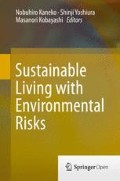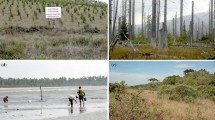Abstract
The current rate of human development poses a major threat to the ecological balance of the environment, and this is exacerbated by climate change effects. It is therefore important for people to understand the ecology of different locations so they can make informed decisions that will not have an adverse effect on the environment. In this regard, students form a significant group for whom sound ecological thinking is necessary as they will be the future leaders and decision makers who can ensure the world’s continued sustainability. This chapter presents the results of an ecological education project that successfully expanded students’ ecological thinking. Evidence of this change is taken from interview responses before and after the ecological education project. The interview was based on a set of six photographs of different situations found in the environment. Responses were analyzed based on an ecological thinking framework developed by the researchers. This framework consisted of two components: understanding of ecology concepts and understanding of the impacts of human activity on ecosystems. The ecological education project succeeded in increasing students’ ecological thinking, thereby increasing their awareness of environmental risks.
You have full access to this open access chapter, Download chapter PDF
Similar content being viewed by others
Keywords
1 Introduction
Of all influences on the global environment, human activities have exerted the greatest impact. The rapid pace of development means that the ecological balance of the environment is faced with enormous threats. Among these, the top five pressures on biodiversity globally are the loss, alteration, and fragmentation of habitats; overexploitation of wild species populations; pollution; climate change; and the introduction of invasive species. These pressures were evidenced by a 28 % decline in the global Living Planet Index between 1970 and 2008. The decline subsequently continued, reaching 30 % in 2012 (WWF 2012). The Living Planet Index is a measure of global biodiversity change based on the world’s vertebrate population.
Meanwhile, the Global Ecological Footprint—a measure of the amount of natural resources consumed globally against the world’s biocapacity—increased continuously. In 2008, the figure was 18.2 billion global hectares (gha). This amounted to 18.2 billion hectares of land to supply the resources necessary to fulfil lifestyle needs and absorb waste for every person on Earth. This means that the Earth requires 1.5 years to regenerate the natural resources that global consumption uses in 1 year (McRae et al. 2008). It is thus necessary to restore, conserve, and protect natural ecosystems and biodiversity so that biological productivity and ecosystem services can be maintained (WWF 2002). This includes preserving the world’s biodiversity and reducing the impact of human activity on natural habitats (WWF 2008a, b). However, realization of these goals requires public support and participation. It is therefore important for people to understand the ecology of different locations so they can make informed decisions that will not have an adverse effect on the environment. Students form a significant group for whom sound ecological thinking is necessary as they will be the future leaders and decision makers who can ensure the world’s continued sustainability.
2 Ecological Thinking
Balgopal and Wallace (2009) reported Berkowitz’s definition of ecological thinking as a combination of ecological understanding and environmental awareness. Ecological understanding refers to understanding of the general concepts in ecology. This includes food webs, trophic levels, carrying capacity, and population dynamics. When people acquire ecological understanding, they tend to also consider their position and role in the ecosystem (Orr 1992, and van Weelie 2002 in Balgopal and Wallace 2009). The definition is further extended to include understanding the impact of human activity on the ecosystem through recognition and application of ecology concepts. This understanding is referred to as ecological literacy (Balgopal and Wallace 2009) and is described as being on a continuum. At one end is the ability to identify dilemmas and propose decisions together with their consequences. This ability diminishes progressively toward the other end of the continuum where there is insufficient understanding to explain how human action impacts on the ecosystem.
The researchers have developed a conceptual framework (Fig. 21.1) based on the definitions given. Ecological thinking involves understanding concepts in ecology including biotic factors, abiotic factors, and biotic interaction. It is complemented by understanding the impact of human activity on ecosystems. Ecological thinking can be improved through ecological education. Improvement of ecological thinking, and understanding the impact of human activity on ecosystems, will eventually lead to increased awareness regarding environmental risk. An ecological education project was therefore conducted with secondary school students as subjects to effect an improvement in their ecological thinking.
3 Case Study
Changes in students’ ecological thinking were investigated. The changes were facilitated by an ecological education project carried out with secondary school students as subjects. In this project, students set up themed organic gardens. They worked in groups and each group created two gardens: a wild garden and a garden on a specific theme chosen by the group. In the wild gardens, plants in the designated area were left to grow freely and no additional fertilizer was applied. In the themed gardens, students planted species they identified as suitable for their chosen theme. This project was conducted for 3 months. During this time, the students collected vermicompost produced by earthworms they reared on cow dung and food waste. They also carried out experiments to compare the effect of using either organic fertilizer in the form of vermicompost, or chemical fertilizer, on the plants in their themed gardens. In addition, they recorded their observations of other organisms found in their gardens.
Data with regard to the students’ ecological thinking were collected using the photo-elicitation interview technique. This is a technique often used in social science by anthropologists and sociologists (Hurworth 2003), as well as in psychology and education, albeit minimally in the latter cases (Harper 2002). Apart from being user friendly and requiring only simple technology to produce, photographs can be used either on their own as content for discussion or as a part of the overall interview process (by varying the way they are presented). Such use enables the interviewer to probe responses about social relationships (Epstein et al. 2006). Furthermore, photo-elicitation incorporates visual language with verbal language (Hurworth 2003) and both interviewer and interviewee share the same visualization that becomes the focus of the interview. Absence of such images requires both parties to conjure their own image of the subject in their minds. In this case congruency of the visualization cannot be ensured as both parties arrive with different experience and prior knowledge.
A total of 140 students aged between 15 and 16 years participated in the project. A sample of students were interviewed prior to its start (pre-test); then they were again interviewed at the end (post-test). Using the photo-elicitation technique, photographs were shown to the students and questions posed to elicit responses (Epstein et al. 2006; Hurworth 2003). The photographs constituted six images of the environment in various situations, as depicted in Fig. 21.2. They included a pristine rainforest, a paddy field, residential apartments, a hill slope being cleared, a riverside settlement, and chemical spraying. Based on the ecological thinking model, the interview covered two aspects, namely understanding of ecological concepts and understanding of the impact of human activity on ecosystems. The students’ responses were probed to gain more information about their thinking with regard to the situations presented in the photographs and their responses. After students were interviewed about the first photograph, they were then interviewed about the second photograph, and this process was repeated until all six photographs had been covered. The same process was followed for both the pre-test and the post-test. Interview data from six students are presented in this case study. Comparison of the pre-test and post-test interview responses is made to identify the changes in their ecological thinking after participating in the ecological education project. The interviews were transcribed and analyzed to extract data relevant to the components of the ecological thinking model. Table 21.1 gives a summary of the findings.
4 Conclusion
The ecological education project succeeded in improving students’ ecological thinking. Their understanding of basic concepts in ecology improved. More importantly, students became more aware of the threats to the environment posed by human activity.
Education is a tool that can enhance understanding of ecosystems in terms of ecological concepts and the effects of human activity on ecosystems. The project undertaken in the case study is one such example. However, there is potential for further research into the ecological thinking of students to assess differences between them with respect to certain demographic factors. Factors for consideration could include their own experience of natural ecosystems, the type of residential area in which they live—rural or urban, for example, or located near a nature reserve or forest—and their worldview.
References
Balgopal MM, Wallace AM (2009) Decisions and dilemmas: using writing to learn activities to increase ecological literacy. J Environ Educ 40(3):13–26
Epstein I, Stevens B, McKeever P, Baruchel S (2006) Photo elicitation interview (PEI): using photos to elicit children’s perspectives. Int J Qual Met 5(3):1–11
Harper D (2002) Talking about pictures: a case for photo elicitation. Vis Stud 17(1):13–26
Hurworth R (2003) Photo-interviewing for research. Social Research Update 40. Accessed from http://sru.soc.surrey.ac.uk/SRU40.pdf
McRae L, Loh J, Bubb PJ, Baillie JEM, Kapos V, Collen B (2008) The living planet index – guidance for national and regional use. UNEP-WCMC, Cambridge
World Wildlife Fund (2002) Living planet report 2002
World Wildlife Fund (2008a) Building a sustainable future. WWF International, Gland
World Wildlife Fund (2008b) A roadmap for a living planet. WWF International, Gland, Switzerland
World Wildlife Fund (2012) Living planet report 2012. Biodiversity, biocapacity and better choices. WWF International, Gland
Acknowledgment
The authors wish to acknowledge the financial support received from the Exploratory Research Grant Scheme 2012 of the Ministry of Education Malaysia.
Author information
Authors and Affiliations
Corresponding author
Editor information
Editors and Affiliations
Rights and permissions
This chapter is published under an open access license. Please check the 'Copyright Information' section either on this page or in the PDF for details of this license and what re-use is permitted. If your intended use exceeds what is permitted by the license or if you are unable to locate the licence and re-use information, please contact the Rights and Permissions team.
Copyright information
© 2014 The Author(s)
About this chapter
Cite this chapter
Esa, N., Yunus, H., Yakob, N., Ibrahim, M.H., Ahmad, M.I. (2014). Enhancing Students’ Ecological Thinking to Improve Understanding of Environmental Risk. In: Kaneko, N., Yoshiura, S., Kobayashi, M. (eds) Sustainable Living with Environmental Risks. Springer, Tokyo. https://doi.org/10.1007/978-4-431-54804-1_21
Download citation
DOI: https://doi.org/10.1007/978-4-431-54804-1_21
Published:
Publisher Name: Springer, Tokyo
Print ISBN: 978-4-431-54803-4
Online ISBN: 978-4-431-54804-1
eBook Packages: Earth and Environmental ScienceEarth and Environmental Science (R0)






